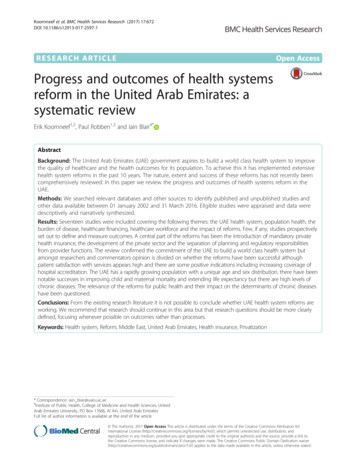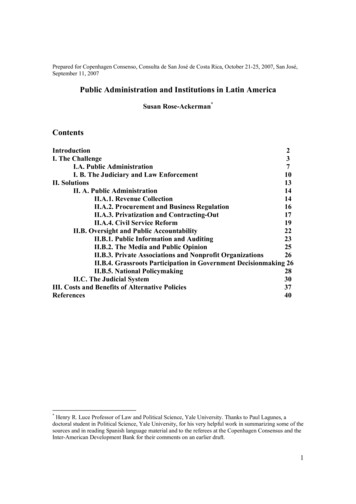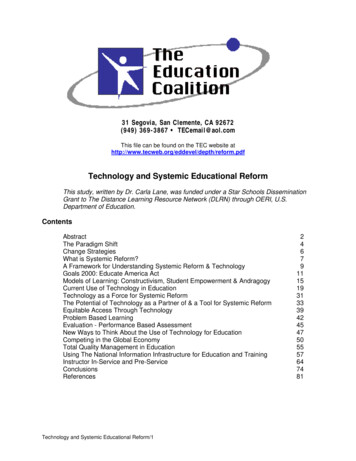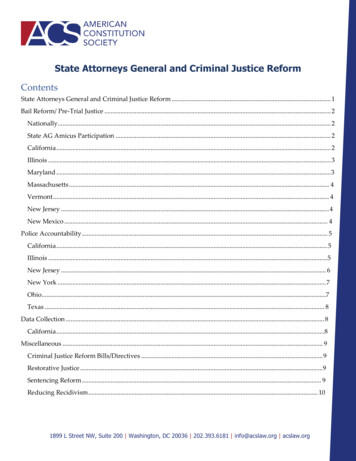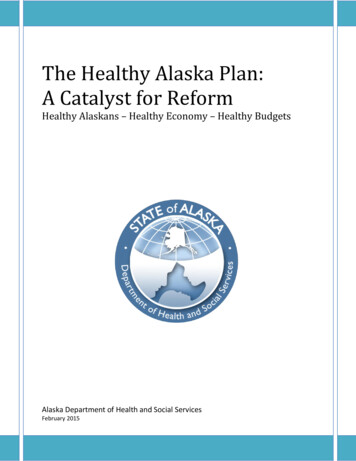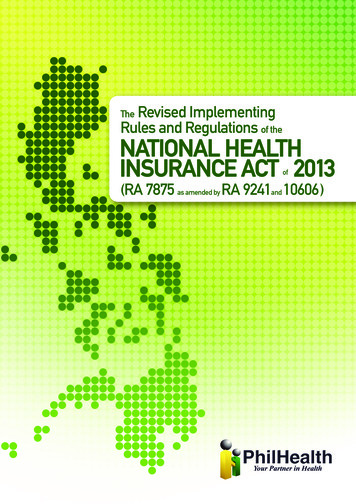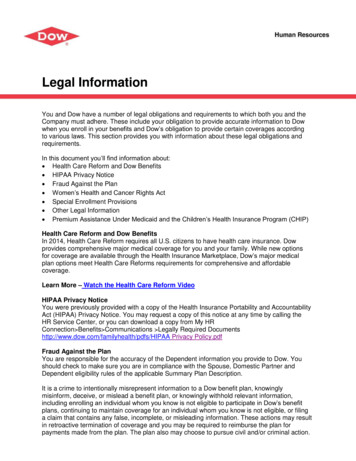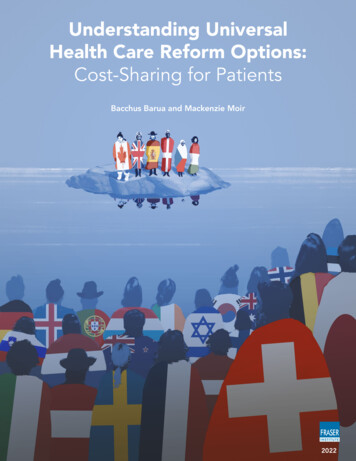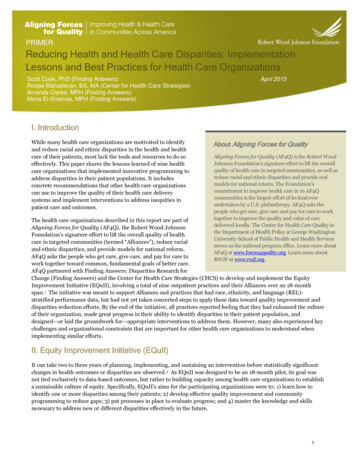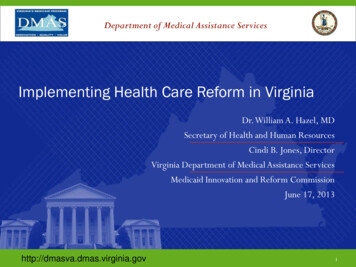
Transcription
Department of Medical Assistance ServicesImplementing Health Care Reform in VirginiaDr. William A. Hazel, MDSecretary of Health and Human ResourcesCindi B. Jones, DirectorVirginia Department of Medical Assistance ServicesMedicaid Innovation and Reform CommissionJune 17, 2013http://dmasva.dmas.virginia.gov1
Per Capita Total Current Health Care Expenditures, U.S. andSelected Countries, 20102Notes: Amounts in U.S. Purchasing Power Parity, see www.oecd.org/std/ppp; includes only countries over 2,500. OECD defines Total CurrentExpenditures on Health as the sum of expenditures 2009 dataon personal health care, preventive and public health services, and health administration and health insurance; it excludes investment.Source: Organization for Economic Co-operation and Development. “OECD Health Data: Health Expenditures and Financing”, OECD Health StatisticsData from internet subscription database. http://www.oecd-library.org, data accessed on 08/23/12.
National Health Expenditures and Their Share of GrossDomestic Product, 1960-2009Dollars in Billions:5.2%37.2%9.2%12.5% 13.8% 14.5% 15.4% 15.9% 16.0% 16.0% 16.1% 16.2% 16.6% 17.6%Source: Centers for Medicare and Medicaid Services, Office of the Actuary, National Health Statistics Group, athttp://www.cms.hhs.gov/NationalHealthExpendData/ (see Historical; NHE summary including share of GDP, CY 1960-2009; filenhegdp09.zip).
4
5Source: Institute of Medicine: The Healthcare Imperative: lowering costs and improving outcomes
Source: Institute of Medicine: The Healthcare Imperative: lowering costs and improving outcomes6
Source: Institute of Medicine: The Healthcare Imperative: lowering costs and improving outcomes7
Source: Institute of Medicine: The Healthcare Imperative: lowering costs and improving outcomes8
Source: Institute of Medicine: The Healthcare Imperative: lowering costs and improving outcomes9
Source: Institute of Medicine: The Healthcare Imperative: lowering costs and improving outcomes10
In Virginia,Reform is Bigger than Just MedicaidVirginiaHealth ReformInitiative11
Goals of Medicaid ReformImproveService DeliveryImproveAdministrationIncrease BeneficiaryEngagementService delivery should beefficient, cost effective,and provide qualityservices.DMAS should beaccountable,streamlined, andtransparent.Individuals should beengaged in, responsible for,and active participants intheir health care.12
Improve Service DeliveryVisionDMAS provides a healthsystem where servicesare coordinated,innovation is rewarded,costs are predictable, andprovider compensation isbased on the quality ofthe care.13
Improve Service Delivery DMAS needs a service delivery system that demonstrates the value ofhealth care provided, where people who can get healthier do so, andcosts are contained. These reforms should work in parallel with otherservice delivery reforms. Through reform, DMAS will improve service delivery bycoordinating services and measuring and rewarding effectiveinnovation and high quality outcomes. Examples of specific reforms to improve service delivery include: Dual Eligible project Paying for quality (Quality Improvement Incentives) Parameters to test innovative local pilot programs (agreed upon by CMS) Coordinated long-term care14
Improve AdministrationVisionDMAS is efficient,streamlined, anduser-friendly. Taxpayer dollars areused effectivelyand for theirintendedpurposes.15
Improve Administration DMAS should operate as a first class organization where fraud,waste, and abuse is mitigated and beneficiaries, providers, andstakeholders are able to understand the program. Through reform, DMAS seeks to improve administration bystandardizing processes and procedures, increasing accountability,and working with CMS to make the program more responsiveand nimble. Examples of specific reforms to improve administration: Fighting Fraud, Waste and Abuse through Program Integrity Establishment of a Data Analytics Unit Veterans Benefit Program (joint venture between DMAS, VDSS, DVS) eHHR16
Increase Beneficiary EngagementVisionBeneficiaries take anactive role in thequality of their healthcare and shareresponsibility for usingMedicaid dollarswisely.17
Increase Beneficiary Engagement DMAS should implement policies that ensure beneficiaries areaccountable for their health care. Through reform, DMAS will identify avenues and strategies toencourage appropriate use of the health care system. Examples of specific reforms addressing this include: Cost sharing for adults Wellness incentives Penalties for using inappropriate care settings (e.g. using the ER whennot needed) or not showing up for appointments18
Three Phases of Medicaid ReformAll Medicaid PopulationsIncluding LTC inCoordinated SystemContinued StakeholderEngagement(Phase III)ImplementingInnovations in ServiceDelivery, Administration,and BeneficiaryEngagement(Phase II)19AdvancingReforms inProgress(Phase I)
Virginia Must Implement MedicaidReform in Three Phases Phase 1: Advancing Current Reforms Dual Eligible Demonstration Enhanced Program Integrity Foster Care New Eligibility and Enrollment System Veterans Behavioral Health20
Virginia Must Implement MedicaidReform in Three Phases Phase 2: Improvements in CurrentManaged Care and FFS programs Commercial like benefit packages and service limits Cost sharing and wellness Coordinate Behavioral Health Services Limited Provider Networks and Medical Homes Quality Payment Incentives Managed Care Data Improvements Standardization of Administrative Processes Health Information Exchange21 Agency Administration Simplification Parameters to Test Pilots
Virginia Must Implement MedicaidReform in Three Phases Phase 3: Coordinated Long TermCare Move remaining populations and waivers intocost effective and coordinated deliverymodels Report due to 2014 General Assembly ondesign and implementation plans22
Medicaid ReformStrategy Highlights Commonwealth Coordinated Care Behavioral Health Services Eligibility System Changes Managed Care Program Integrity23
Virginia’s Dual Eligible DemonstrationImproving Care for Medicare-Medicaid Enrollees24
Medicare-Medicaid Enrollees? Receive both full benefitMedicare and Medicaidcoverage 58.8% age 65 or older 41.2% under age 65 Often have multiple,complex health careneeds.25Over 9 million Americans are eligiblefor Medicare and Medicaid (known asMedicare-Medicaid enrollees)
Medicare and Medicaid Today Medicare and Medicaid are not designed to work togetherresulting in an inefficient, more costly delivery system Costs of serving individuals on Medicare and Medicaid arerising exponentially Each program has its own set of rules, regulations,requirements and coverage At the national level we are spending 39% of Medicaidfunds on 15% of the population*We can’t afford to continue to supportrising costs without intervention*26
Who Pays for Services in Virginia?MEDICARE Hospital care Physician & ancillary services Skilled nursing facility (SNF) care(up to 100 days) Home health care Hospice Prescription drugs Durable medical equipment27MEDICAID Nursing facility (once Medicarebenefits exhausted) Home- and community-basedservices (HCBS) Hospital once Medicare benefitsexhausted Optional services: personal care,select home health care,rehabilitative services, somebehavioral health Some prescription drugs notcovered by Medicare Durable medical equipment notcovered by Medicare
What does care look like for MedicareMedicaid enrollees now?WITHOUT COORDINATED CARE INDIVIDUALSMAY HAVE:xThree ID cards: Medicare, Medicaid, and prescriptiondrugsxThree different sets of benefitsxMultiple providers who rarely communicate28xHealth care decisions uncoordinated and not made fromthe person-centered perspective
The Solution:Commonwealth Coordinated Care Provides high-quality, person-centered care forMedicare-Medicaid enrollees that is focused on theirneeds and preferences Blends Medicare’s and Medicaid’s services andfinancing to streamline care and eliminate cost shifting29
The Solution:Commonwealth Coordinated Care Creates a single program to coordinate delivery of primary,preventive, acute, behavioral, and long-term services andsupports Promotes the use of home- and community-basedbehavioral and long-term services and supports Supports improved transitions between acute and long-term facilities30
31
Who is Eligible? Full benefit Medicare-Medicaid Enrollees includingbut not limited to: Participants in the Elderly and Disabled withConsumer Direction Waiver, and Residents of nursing facilities Age 21 and Over Live in designated regions (Northern VA, Tidewater,Richmond/Central, Charlottesville, and Roanoke)32
33
Medicare-Medicaid Enrollees in Virginiaeligible for Commonwealth Coordinated CareApproximately 78,600 Medicare-Medicaid EnrolleesRegion34Nursing Facility EDCD WavierCommunityNon-waiverTotalCentral VA4,4303,76216,13524,327Northern 1,3558,58312,771Total13,70610,21754,67278,596
Benefits for Virginia Promotes and measures improvements in quality of life andhealth outcomes Eliminate cost shifting between Medicare and Medicaid andachieve cost savings for States and CMS Reduce duplicative or unnecessary services Streamline administrative burden with a single set ofappeals, auditing and marketing rules, and quality reporting Efficiencies gained through this program are likely to yieldfinancial savings to Virginia. DMAS budget forecast for statefiscal year 2014 included 11.3 million in general fundsavings.35
StakeholderInput and Support Created a formal Advisory Committee Requests put in the MOU Required behavioral health homes for SMI population Emphasis on transitions between settings of care Waived Skilled Medicare hospital stay Followed Medicaid rules for Telehealth Required standard fiscal agent for consumer directedservices Required Plans to describe how they will reimburse nursingfacilities; minimize administrative burdens36
In the coming weeks . Announcement of the selection of HealthPlans participating in CommonwealthCoordinated Care Formation of workgroups to design andimplement various components ofCommonwealth Coordinated Care Continued Outreach and Education37
Efforts to Improve Quality of Care for IndividualsReceiving Community Mental HealthRehabilitative Services38
Community Mental HealthRehabilitative Services (CMHRS) State Plan Option (SPO) Services Not a part of the mandatory Medicaid package, but areservices that the legislature requested to be included in theVirginia Medicaid program Once added, however, they become available to allMedicaid beneficiaries who meet criteria for the service(s) Examples include: psycho-social rehab, intensivecommunity treatment, and mental health support services SPO behavioral health services are not typicallycovered by private insurers Those typically covered are already in managed care (i.e.,psychotherapy, psychological assessments)39
Who benefits from CMHRS? Children who have a serious emotional disturbance(SED) who need behavioral health supports andservices Adults who have a serious mental illness (SMI) whoneed behavioral health supports and services Adults who are substance users (including pregnantwomen) who are in need of substance abuseservices40
Concerns Regarding CMHRS Behavioral health services have grown significantly overthe past several years One of the top four fastest growing areas in Medicaid Quality of services in question; care tends to beuncoordinated DMAS noticed the increase and took measures to controlcosts and ensure quality care Implemented prior authorization and increasedutilization review activities; Decreased the rate for Intensive In-Home services; Formed the Office of Behavioral Health in January 201041
Behavioral Health Service Utilization Behavioral Health Expenditures in 2012 reached 682,749,358 for non-traditional services FY 2000 expenditures - 3.6 million (non-traditionalservices opened up to private providers in this year) This total represents 9% of expenditures for theMedicaid/FAMIS programs, representing over 109,000covered individuals Expenditures for these services have increased by 18%between 2009 to 20124242
DMAS Activities to Improve Services Regulated marketing tactics Tightened staff qualifications Implemented an independent clinical assessment process43for children under 21 years of age New regulations expected Fall 2013 to improve staffqualifications and documentation requirements forCMHRS Emergency regulations under development to revampMental Health Support Services Development of the Behavioral Health ServicesAdministrator contractw43
The Need for Coordinated Care andImproved Health Outcome Monitoring Data showed a majority of children receiving moreintensive behavioral health services had not beenpreviously known to behavioral health service deliverysystem or to their MCOs as having behavioral health needs This trend is now occurring with adults Virginia does not currently collect quality outcome data toshow how Medicaid members are benefitting from theseservices4444
Authority The 2011, 2012, and 2013 Acts of Assemblydirected DMAS to implement a coordinated caremodel for individuals in need of behavioral healthservices that are not currently provided through amanaged care organization4545
Improved Care Coordination forBehavioral Health Services In December 2011, DMAS released a Request forProposals for an Administrative Services Organization(ASO) to coordinate behavioral health services The ASO is a non-risk model where a BehavioralHealth Services Administrator (BHSA) will be paid aper member, per month administrative fee tocoordinate behavioral health services4646
Value Added ServicesBeginning in December 2013, the BHSA willprovide: Management of a 24/7 centralized call center to provide 47 information on eligibility, benefits, claims, referralassistance and appeals;Quality Care Initiatives –psychotropic medications,integrated care;Interface with Medicaid MCOs;Service Authorization and Utilization Management; andMember outreach and education.47
Service ProvidersThe BHSA will manage the behavioral healthnetwork by : Enrolling and credentialing fee-for-service behavioral 48health providers (Federal and State compliant) ;Conducting provider performance reviews;Maintaining open communication regarding patient careneeds and options;Processing and paying claims; andAnalyzing geographical access needs.www.dmas.virginia.gov48
Eligibility and Enrollment Changes forMedicaid49
eHHR Connection to Medicaid Reform Automation in VaCMS and Rules engine will help reduce VDSSand LDSS workload over time Data and analysis tools integrated through eHHR agencies canguide Medicaid Reform changes Benefit Policy changes defined by Medicaid Reform can moreeasily be made in the rules engine (weeks vs. months) Access to real-time data from the Federal Data Service Hub(FDSH) and COV sources can help automate eligibility criteriadefined in Medicaid Reform50
eHHR Key Dates2013 July – VaCMS system testing scheduled to begin withCMS October – New VaCMS eligibility system goes live fornew Medicaid/FAMIS; Begin taking Medicaid/FAMISapplications based on PPACA/MAGI512014 January – Eligibility based on ACA/MAGI rules requiredto begin April – Current Medicaid/FAMIS customers startmigrating to the new VaCMS eligibility system
eHHR Key Dates2015 October - Other programs (SNAP, TANF, LIHEAP, etc.)go live on new VaCMS system December– Complete all eHHR development funded byCMS (federal end date for the funds to be used) Begin retirement of the ADAPT mainframe52
eHHR TimelinesStatusMAGI project ison-schedule,yellow status.Conversion andMigrationprojects aregreen and onschedule53
Changes to the Managed Care Program54
MCOs StatewideJuly 1, 2012legend55
700,000 enrollees inMedallion II56
MEDALLION 3.0 ReformsJuly 1, 2013: New Contract / New Program Total revamping after researching best practices of 13 states and2 state site visits Collaboratives with CHCS, NASHP, and NAMD Created 4 business units– Operations– Financial– Reporting and Systems57– Business Analysis and Development
MEDALLION 3.0 ReformsIncludes more commercial plan benefit features, enhanced servicesand reporting, increased innovation: Chronic Care and Assessments Wellness Programs Maternity Program Changes Enhanced Data and Reporting New Populations New Rate and Data Analysis Enhanced Program Integrity Requirements58
MEDALLION 3.0 - Top 3 Upgrades1. Quality Incentive Program Withhold an approved percentage of the monthly capitationpayment from the MCO Funds will be used for the MCO’s performance incentive awards Criteria to include assessment of performance in quality of careand member experience; composite scores on CAHPS adult andchild measures; performance in EQRO-conducted activities; andother measures determined by the Department Awards proportionate to MCO benchmarks achievements foreach performance measure59 Implemented in a three-year phased-in schedule
MEDALLION 3.0 - Top 3 Upgrades2. Medallion Care Partnership System (MCSP) – newpayment/delivery model Each MCO to implement at least two MCSPs to improve healthoutcomes for Medicaid members through a system designed tointegrate primary, acute, and complex health services Gain and/or risk sharing, performance-based incentives, orother incentive reforms tied to Commonwealth-approvedquality metrics and financial performance, and partnershipswith providers and/or health care systems Integrated provider health care delivery systems participation,improvement of member health outcomes as measured throughrisk adjusted quality metrics, and alignment of administrativesystems to improve efficiency and member experience60
MEDALLION 3.0 - Top 3 Upgrades3. Plan Collaboratives Quality - open discussion on challenges, best practices, andlessons learned Program Integrity – address state, federal, and CMSinitiatives Innovation and Reform – explore innovative solutions tothe cost and health care delivery challenges Foster Care – address the requirements of the VirginiaHealth Care Oversight and Coordination Plan61
Spotlight on Program Integrity62
Provider EnrollmentService AuthorizationPrepaymentClaims Processing /MMIS EditsRecipient Monitoring UnitThird Party LiabilityPayment IntegrityPreferred Drug List & RebatesAnnual Audit PlanData Analysis andProvider SelectionProvider Exception ReportsReferrals and Re-reviewsProvider Review UnitData AnalyticsRecipient Auditing UnitPostpaymentPERM ClaimsReviewProviderAuditsRecipientAuditsContract Compliance UnitContract Utilization Review UnitCost SettlementHospitalAuditsMentalHealth Audits
Prepayment Prepayment processes enhance cost avoidance by preventingimproper expenditures on services that are not medically necessary,or providers who are not eligible to participate in Medicaid andensure claims are paid according to DMAS policy Provider Enrollment – Screening and managing the FFS network Service Authorizations – 1300 procedures saving 190M annually Claim Edits – ClaimCheck and CCI edits saved 39M Data Analysis and tests VICAP and Magellan, Inc – BHSA - Community mental health(future)64
Post-payment Post-payment processes identify instances of improperprovider billings through data and risk analysis, investigation ofreferrals and audits of paid claims Staff and Contractor’s Audits – 900 audits annually Contractors: HMS Inc, Meyers Stauffer and Xerox/ACS New Contracts: Fraud, Waste and Abuse, Recovery Audit Third Party Liability MCO Collaborative MFCU Referrals, Qui Tam, and 55M in prosecutions65
DMAS Program Integrity Life Analysis66
Mandatory Affordable Care Act Provisions67
Compliance withthe Affordable Care Act Extended coverage for Foster Care Children Changes to Notifications (letters), Appeals andComplaints processing New Presumptive Eligibility workflow for hospitals Applications for coverage must be coordinated inreal-time with the Federal Exchange and includeelectronic transfer between Medicaid and subsidized(exchange) coverage68
Compliance withthe Affordable Care ActComplete replacement of Medicaid eligibility criteria: Modified Adjusted Gross Income (MAGI): As ofJanuary 1, 2014, PPACA modifies the way states willcalculate income for many existing coverage groups,primarily children, pregnant women, and lowincome adults with children Applications must be accepted on paper, on-line, byphone and by fax69
Compliance withthe Affordable Care Act A new Eligibility and Enrollment (E&E)system and administrative structural changesare required to comply with MAGI and otherprovisions of PPACA for the existing population.Requires Call Center. Eligibility criteria must be checked real-time withSocial Security Administration, IRS, HomelandSecurity70
Payment/Provider Provisions with aSubstantial Impact on Virginia The ACA contains substantial payment/provider reforms: Mandated reductions in federal Disproportionate ShareHospital (DSH) payment under Medicaid (ifmaintained, recently proposed rules will modifyimplementation timing) Two year mandated increase in payment for PrimaryCare Physician Services (up to Medicare paymentlevels) Significant federal changes and state administrative71complexity in Medicaid provider screening,enrollment and termination requirements
Implementing Medicaid Reform72
Medicaid Reform to Date The 2013 General Assembly mandated that DMASmake reforms to the existing Medicaid program Outlined Medicaid reforms in 3 phases Medicaid Reform Matrix posted in May to solicitstakeholder responses on DMAS’ current plans toimplement Medicaid Reform Virginia Health Reform Initiative (VHRI) met lastweek (June 12) to provide feedback to DMAS73
Summary of Medicaid Reform ActivitiesModernizing the Medicaid ProgramNew Managed Care ContractBehavioral Health Services AdministratorCommonwealth Coordinated CareTransitioning populations still in FFS into managedcare for basic health services74Transitioning all remaining long-term care servicesinto managed care
Behavioral Health Service Utilization Behavioral Health Expenditures in 2012 reached 682,749,358 for non-traditional services FY 2000 expenditures - 3.6 million (non-traditional services opened up to private providers in this year) This total represents 9% of expenditures for the Medicaid/FAMIS programs, representing over 109,000


